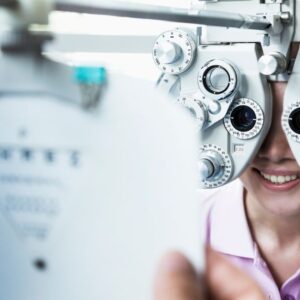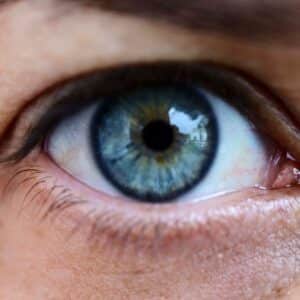Contact lenses are small, plastic, or other curved metal discs that fit over the eyes. They help correct vision problems such as nearsightedness, farsightedness, and astigmatism, and they can also be used for cosmetic purposes like changing the color of your eyes.
Contact lenses are worn directly on the eye, unlike eyeglasses worn in front of the eyes.
Contact lenses must be properly cleaned and disinfected before use, and they should be replaced regularly as recommended by an eye doctor.
What Types of Contact Lenses are Available?
Several types of contact lenses are available, including:
- Soft contact lenses: These are made from a gel-like material that allows oxygen to pass through to the eye. They are comfortable to wear and are available in various prescriptions, including for near-sightedness, far-sightedness, and astigmatism.
- Rigid gas-permeable (RGP) contact lenses: These are made from a hard but permeable material that allows oxygen to reach the eye. They offer sharper vision than soft contact lenses but are less comfortable and take longer to get used to.
- Daily disposable contact lenses: These are worn for one day and then thrown away, eliminating the need for cleaning and disinfecting.
- Extended-wear contact lenses: These can be worn overnight for up to a week, depending on the type.
- Colored contact lenses: These are available in various colors and can be worn for cosmetic or therapeutic reasons, such as to correct color blindness.
- Multifocal contact lenses have different prescriptions in different parts of the lens, allowing the wearer to see clearly at all distances.
- Specialty contact lenses: These are designed for specific needs, such as for people with keratoconus, an irregular shape of the cornea.
Wearing contact lenses requires a prescription from an optometrist or ophthalmologist. Always follow their instructions, as contact lenses are considered medical devices and can be damaging if not used correctly.
How To Choose the Right Contact Lenses
When selecting contact lenses, there are many factors to think about. Your lifestyle, vision needs, and personal preferences should all be considered when making your decision. Things to consider when choosing contact lenses include the following:
- Prescription: The first step is to visit an optometrist or ophthalmologist to get a prescription for contact lenses. They will determine the type of lenses that suit your eyes and vision needs.
- Material: Soft contact lenses are the most popular because they are comfortable to wear and available in many prescriptions. Rigid gas-permeable (RGP) contact lenses are also an option, but they are less comfortable and take longer to get used to.
- Replacement schedule: Daily disposable contact lenses are convenient because they eliminate the need for cleaning and disinfecting, but they can be more expensive in the long run. Extended-wear contact lenses can be worn overnight, but they must be replaced more frequently.
- Lifestyle: If you are active, consider contact lenses that won’t dry out easily. If you work in front of a computer, consider contact lenses with a higher oxygen permeability to prevent dry eyes.
- Personal preference: Some people prefer the feel of soft contact lenses, while others prefer the sharper vision of RGP contact lenses. It’s also essential to choose a lens that you feel comfortable wearing.
- Cost: Contact lenses can vary, so it’s essential to consider your budget when choosing a lens. Daily disposable contact lenses can be more expensive in the long run but can be more convenient.
Following the optometrist’s or ophthalmologist’s instructions regarding the usage duration, cleaning, and the lens replacement schedule is crucial. This will help to avoid any eye infections and keep your eyes healthy.
How Can I Keep my Contact lenses Clean and Sanitary?
Following a regular cleaning and disinfection routine is essential to keep your contact lenses clean and sanitary. Here are some tips for maintaining your contact lenses:
- To put in or remove contact lenses, start by thoroughly washing your hands with soap and water. Make sure to dry off using a lint-free towel so that no fibers remain on your fingers. Then, you’re ready to insert or remove your contact lenses!
- Use a disinfecting solution to clean your contact lenses. Never use tap water, saliva, or homemade solutions to clean your lenses.
- To properly clean contact lenses, take your lenses and rub them gently with your finger for a minimum of 20 seconds. After that, rinse the lenses with a disinfecting solution to ensure any bacteria or dirt is washed away.
- Place the contact lenses in a clean case and fill the case with a new disinfecting solution.
- Allow the contact lenses to soak for the recommended time specified by the solution manufacturer. Some solutions require a minimum of four hours of disinfection time, while others may be used overnight.
- When you’re ready to wear the contact lenses, remove them from the case and rinse them with the disinfecting solution before inserting them into your eyes.
- Disposable contact lenses can be worn once and then thrown away. Daily disposable contacts make wearing and changing out contact lenses easy, as there is no need to clean or store them.
- Replace your contact lens case every three months or as instructed by an eye specialist. This helps reduce the risk of infection associated with contact lenses and ensures your eyes remain healthy.
- Never reuse the disinfecting solution or top off the solution in the lens case. Always use a fresh disinfecting solution each time you clean your lenses.
It’s also essential to have regular check-ups with your eye care professional to ensure that your contact lenses fit well and that your eyes are healthy.
Are There Any Health Risks Associated with Contact lenses?
Yes, there are several health risks associated with contact lenses. Here are a few of the most common:
- Eye infections: Contact lenses offer an excellent alternative to eyeglasses for those who need vision correction. However, these lenses can also increase the risk of eye infections, such as keratitis, conjunctivitis, and corneal ulcers. The bacteria, fungi, or viruses that cause these infections can cause severe complications and may even lead to blindness if left untreated.
- Allergic reactions: Contact lenses can cause allergic reactions in some people due to the material used in them or the disinfecting solutions used for cleaning. These reactions can range from mild irritation to severe eye discomfort and redness.
- Dry eyes: Contact lenses can be beneficial in providing clear vision. However, they can lead to dry eyes. This causes discomfort and increases the risk of infection due to a lack of proper moisture around the eye.
- Corneal abrasion: Wearing contact lenses can result in a corneal abrasion, an injury that occurs when the eye’s surface is scratched. This is uncomfortable and painful and can also lead to potential infections.
- Hypoxia: Wearing contact lenses can decrease the amount of oxygen supplied to the eyes, potentially resulting in a dangerous condition referred to as hypoxia. This breakdown in eye oxygenation can cause unusual blood vessel growth, leading to severe issues, including blindness.
- Acanthamoeba keratitis: a serious eye infection caused by Acanthamoeba microorganisms, is often linked to contact lens use. If left untreated, this infection may lead to inflammation and scarring of the cornea, leading to vision loss or blindness. Therefore it is important to take precautions when wearing contacts and follow proper contact lens hygiene.
- Giant papillary conjunctivitis (GPC) is an inflammatory reaction of the inner surface of the eyelid caused by wearing contact lenses. It can cause redness, itching in the eye, and increased sensitivity to light and pain.
You must take proper care of your contact lenses and follow the instructions of your eye care professional to minimize the risk of these health risks. If you experience any symptoms, such as pain, redness, discharge, or discomfort, you should remove the lenses and seek immediate medical attention.
Signs of a Serious Eye Injury With Contact Lenses
Several signs may indicate a serious eye injury while wearing contact lenses. Some of these signs include:
- Severe pain or discomfort in the eye
- Redness, swelling, or discharge from the eye
- Blurred vision or difficulty seeing
- Light sensitivity or halos around lights
- A feeling that something is in the eye
- A change in the color of the iris
- A sudden decrease in vision
- A change in the shape of the cornea
If you experience any of these symptoms while wearing contact lenses, removing them and seeking immediate medical attention is crucial. Eye injuries can lead to severe complications such as infection, vision loss, or permanent damage to the eye if not treated promptly.
If you are unsure if you have a serious eye injury, it is always better to be safe and consult an eye doctor.
Change Your Contact Lenses at the Right Frequency
The frequency at which you need to change your contact lenses depends on the lenses you use.
- Daily disposable contact lenses are worn for one day and then thrown away. They do not need to be cleaned or disinfected.
- Extended-wear contact lenses: These lenses can be worn for up to seven days without removal but should be removed, cleaned, and disinfected at least once a week.
- Disposable contact lenses: are worn for limited periods, such as two weeks or one month. After wear, these lenses must be disposed of and replaced according to the recommendations given by an eye doctor.
- Reusable contact lenses: They are generally worn between one and two years, after which they must be replaced. Daily cleaning and disinfection are required to ensure that these lenses remain hygienic and comfortable for their entire useable lifespan.
Following the recommended schedule for changing your contact lenses is essential, as wearing worn-out lenses can increase the risk of eye infections, irritation, and damage.
Your eye specialist can help you determine the appropriate replacement schedule for your specific type of lenses.
Summary
Contact lenses are small, thin, curved pieces of plastic or silicone placed directly on the eye’s surface to correct vision problems.
They come in different types, including daily disposable, two-week, and monthly disposable, and can be used to correct various vision problems, such as nearsightedness, farsightedness, and astigmatism.
They are typically inserted in the morning, removed at night, and cleaned and disinfected regularly to maintain proper hygiene and prevent eye infections.
Contact lenses can be a convenient alternative to glasses for some individuals, but they also require proper care and regular eye exams to ensure safe and effective use.






